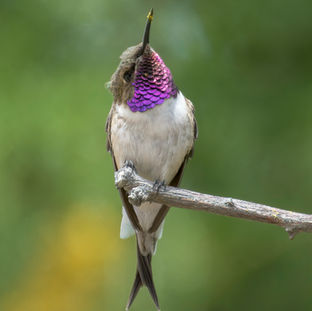
Chilean
Woodstar
©anthony-lujan
About
Scientific name: Eulidia yarrellii
Location: Northern Chile: Atacama Desert
IUCN Status: Critically Endangered
Population: Fewer than 500
Trend: Decreasing
Main Threats: Habitat Loss, Pesticide use, Competition with the Peruvian Sheartail

©anthony-lujan
The Chilean Woodstar is one of the world’s rarest and most threatened hummingbirds. Found in the driest desert in the world, the Atacama Desert, Chilean Woodstars have seen their habitat changed and their population shrink dramatically over the past decades, resulting in this tiny bird teetering on the brink of extinction.
Despite the Atacama Desert being the driest region in the world, the surrounding fertile valleys provide abundant riparian vegetation and stable climatic conditions year-round. Now, due to habitat destruction from burning of riparian vegetation, the destruction of traditional olive orchards used for nesting, and intensive agriculture use of pesticides that cause direct poisoning or indirect contamination of important nectar sources, the Chilean Woodstar population is under threat. Coupled with competition from the Peruvian Sheartail (Thaumastura cora), a species that spontaneously colonized the region and has seen steady population growth over the past few decades, the Chilean Woodstar is near extinction.
Since 2003 the Chilean Ornithologist’s Union (AvesChile), has been monitoring the species’ population size through annual surveys. The surveys show a steep population decline from about 1500 individuals in 2003 to the current estimate of below 500.
The survival of the Chilean Woodstar depends on immediate and sustained conservation actions to protect and restore its natural habitat. The International Hummingbird Society is funding a project that lays the groundwork for restoring habitat in an important section of the Chaca Valley where Chilean Woodstars live. Help us support the conservation of these critically endangered hummingbirds.

©cristian-f-estadesr
©anthony-lujan
©anthony-lujan
The Chilean Woodstar (Eulidia yarrellii) is the smallest bird in Chile, measuring about 3 inches (7.5cm) in length and weighing about 2.5 grams. Males are distinguished by their iridescent olive-green upperparts, a striking violet-red and blue throat, and a distinctive crossed, forked tail. Females are more subdued in their coloration.
Challenging Characteristics
During the mating season males gather in "leks," established locations close to other males. Here they display courtship dances and compete for the attention of visiting females who are there to choose a mate. Research suggests that males will return to the same location annually, even when the habitat in the lek area deteriorates. This behavioral inflexibility poses challenges for conservation efforts, as the birds may continue to use deteriorated habitats that are no longer optimal for breeding — or even surviving.
Protecting the areas where these leks or nesting sites exist is extremely difficult due to the agricultural activities that drive up the price of land, and current regulations severely limit the capacity of Chile’s Government to acquire land for conservation purposes.
Outside the reproductive season, from February to August, Chilean Woodstars are rarely seen in the valleys and probably migrate to higher elevations in the Andean foothills. Additional research could be beneficial to gain a better understanding of their non-breeding locations.

©anthony-lujan
Chilean Woodstar Conservation Project
In April 2025, the International Hummingbird Society funded a $5680 project that lays the groundwork for restoring habitat in an important section of the Chaca Valley where Chilean Woodstars live. Because most of the land in this area is privately owned, conservation efforts are focusing on establishing a network of microreserves. The newest potential reserve is a nearly 40-acre (15.4 hectare) plot that is a little more than a mile from the existing 25-acre (10.4 hectare) Arica Hummingbird Natural Monument. In April, the proven Chilean conservation organization Red de Observadores de Aves y Vida Silvestre de Chile (ROC) was granted a concession to manage the new microreserve for conservation. It has a well with water and an irrigation system that can potentially be used for planting natural vegetation. Through our relationship with American Bird Conservancy, we are funding the first phase of developing this plot. Approximately one-half of the land does not currently have vegetation, but by re-establishing water access and planting trees (1000 trees will be contributed by the Chilean National Forestry organization, CONAF) nearly the entire 40 acres could become desperately needed functioning habitat for Chilean Woodstars.
The initial project work will be followed up with additional habitat restoration and maintenance activities. Your support will help ensure that this very important effort to save desperately needed habitat for the Chilean Woodstar continues. Please help us in our efforts to save this amazing bird from extinction. Donate now so that we can continue to fund these projects to restore their habitat.



